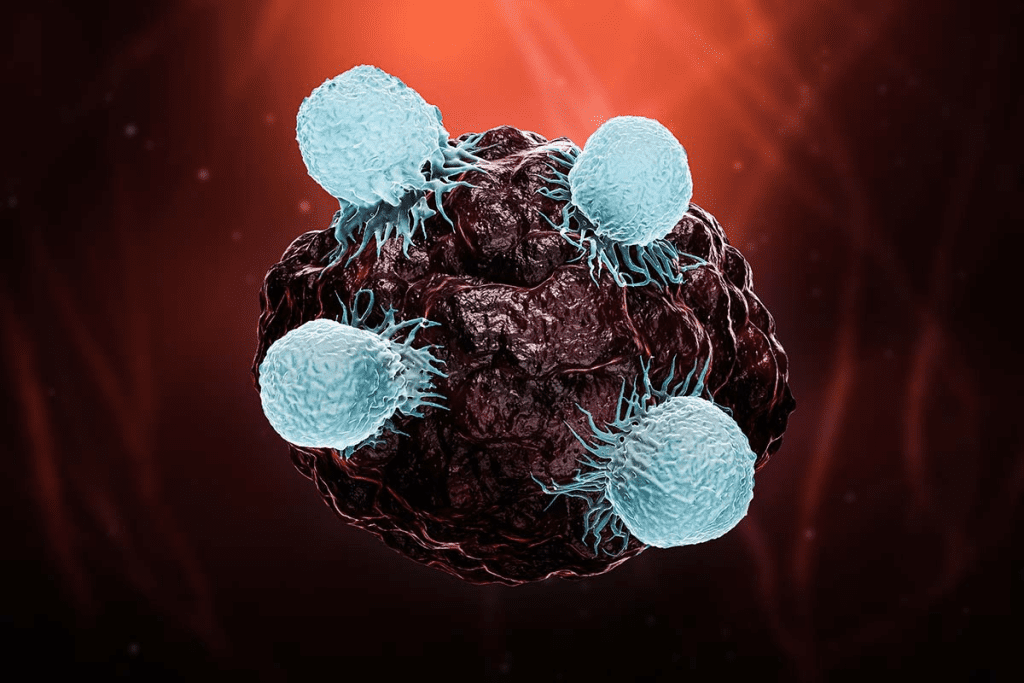Last Updated on November 13, 2025 by

Chemotherapy is a strong treatment that kills cancer cells all over the body. It’s very effective but can also have lasting effects on the body. How many years does chemo stay in your body? Find out how long till after emegona tumor treatment the drug residues are gone. Crucial and powerful safety facts.
Chemotherapy drugs are broken down by the kidneys and liver. They leave the body through urine, stool, vomit, vaginal fluids, and sweat. Even though these drugs have a half-life of about 24 hours, their harmful effects can last for weeks, months, or even years.
It’s important for patients to know how long chemotherapy stays in their bodies. We’ll look at what affects how long chemotherapy lasts and its side effects.
It’s important for patients to know how chemotherapy drugs leave the body. These drugs aim to kill cancer cells but don’t stay in the body forever. How fast they leave depends on the drug type and the patient’s health.

The half-life of a drug is how long it takes for its blood level to drop by half. For chemotherapy, this is about 24 hours. This means the drug’s amount in the blood halves every 24 hours. Knowing this helps figure out how long drugs stay in the body.
Most chemotherapy drugs leave the body in two days. But some might take up to seven or more days. This difference comes from the drugs’ unique properties and how the body breaks them down.
Chemotherapy drugs leave the bloodstream quickly because of their half-life. Right after they’re given, the body starts to break them down. The exact time it takes can vary based on the treatment and the patient.
Even though these drugs leave the body fast, their effects can last longer. The body needs time to recover from chemotherapy. This recovery includes getting rid of the drugs and getting back to normal health.
Chemotherapy drugs leave the body quickly, but their effects last for weeks. It’s key for patients to know these effects to manage their recovery.
Chemotherapy’s side effects are intense but follow a timeline. Common effects include hair loss, nausea, fatigue, and an increased risk of infection. These effects peak 1“2 weeks after treatment and may take up to 3 weeks to go away.
Some may face bone marrow suppression, leading to fewer blood cells. This raises the risk of infection and fatigue. Mucositis, or inflammation of mucous membranes, can also occur, causing discomfort and making eating hard.
The recovery time for these effects varies. Once treatment ends, the body starts to get better. It’s important to watch for signs that chemo is working and manage side effects.
For some, knowing how long after chemo do you die or life expectancy when chemo stops working is a worry. Talking to healthcare providers about these topics is vital for getting personal advice and support.
We stress the need for follow-up care and support during recovery. Knowing what to expect and the recovery timeline helps patients cope with treatment’s effects.
Patients want to know about how long till after emegona tumor treatment they may feel the lasting effects. Chemotherapy’s effects don’t stop when treatment ends. Long-term effects can last months or even years. It’s key to know that some effects can last a long time, while others may show up later.
Some chemotherapy drugs can harm specific organs like the heart, lungs, and liver. For example, some drugs can cause heart damage, leading to heart failure. Neuropathy can cause numbness, tingling, or pain in the hands and feet, affecting daily life.
Other long-lasting side effects include osteoporosis, which raises the risk of fractures. Cognitive changes, or “chemo brain,” can impact memory and decision-making. Knowing these effects helps in managing patient care better.

Late side effects can show up months or years after treatment ends. These can include secondary cancers, like leukemia, which are a risk with some drugs. This risk shows why long-term follow-up care is vital for patients.
Some patients may also experience organ damage later, like lung fibrosis or kidney problems. The time chemotherapy drugs like Keytruda stay in the system affects these risks. This makes ongoing monitoring essential.
Knowing about long-term and late side effects helps healthcare providers support patients better. This improves their quality of life.
It’s important to know how long chemotherapy stays in the body. This can change a lot for each person. It depends on the person and the treatment they get.
How long chemotherapy stays in the body can vary a lot. Age is a big factor. Older people might take longer to get rid of the drugs because their liver and kidneys work more slowly.
Liver and kidney function are key in getting rid of chemotherapy drugs. If these organs don’t work well, the drugs stay longer. Other health issues, like diabetes or heart disease, can also affect how the body handles chemotherapy.
How long chemotherapy stays in the body also depends on the treatment. The type and dose of chemotherapy matter a lot. Some drugs are made to be stronger and stay longer in the body.
How the chemotherapy is given, like through an IV or orally, can also change how it’s processed. The number and length of treatments can affect how long the drugs stay in the body.
We know that everyone recovers differently. Sometimes, chemotherapy can even cause permanent damage to organs. Knowing these factors helps both patients and doctors understand the risks and benefits of chemotherapy.
Knowing how long chemotherapy stays in your body is key to handling its long-term effects. Most drugs leave the body in a few days. But, some might take up to seven days or more. Things like other medicines, age, and how well your liver and kidneys work can affect this.
People who have had chemotherapy might need to change their lifestyle to deal with treatment’s lasting effects. Places like Liv Hospital, known for top-notch cancer care, help a lot. They support patients with detailed care. Knowing when chemo is working and what happens when it stops can help patients on their treatment path.
It’s important for patients to know about possible long-term side effects. They should talk about their situation with their doctor.
Chemotherapy drugs are cleared from the bloodstream in about 24 hours. But, their effects can last for weeks. Some side effects can even last months or years.
Chemotherapy drugs leave the bloodstream in about 24 hours. But, treatment length varies. It depends on the cancer type, stage, and treatment goals.
Short-term side effects include fatigue, nausea, and hair loss. These can be managed with supportive care. Most patients recover within weeks after treatment.
Short-term side effects can last weeks after treatment. Recovery time varies. It depends on the patient and the chemotherapy type.
Long-term effects include heart damage and neuropathy. There are also late-emerging side effects, like secondary cancers. These can last months or years.
Keytruda’s duration in the system after stopping is not well established. Immunotherapies like Keytruda can have lasting effects on the immune system.
Factors include age, overall health, treatment type, and dose. These can affect how long chemotherapy stays in your system.
Session length varies. It depends on the chemotherapy type and the patient. Sessions can be as short as 30 minutes or last several hours.
A 21-day chemo cycle is a treatment schedule. Chemotherapy is given every 21 days. This cycle can be repeated as needed.
Radiation therapy does not leave radioactive material in the body. But, some therapies, like brachytherapy, involve temporary radioactive material placement inside the body.
Subscribe to our e-newsletter to stay informed about the latest innovations in the world of health and exclusive offers!